Case Study: Observing Learning and Development
VerifiedAdded on 2023/01/19
|16
|3682
|76
AI Summary
This case study explores the role of early childhood programs in shaping the future growth of children. It examines the interests, learning needs, and teaching strategies for a child named Shine at different stages of her life. The impact of background and socio-cultural factors on child growth is also discussed.
Contribute Materials
Your contribution can guide someone’s learning journey. Share your
documents today.
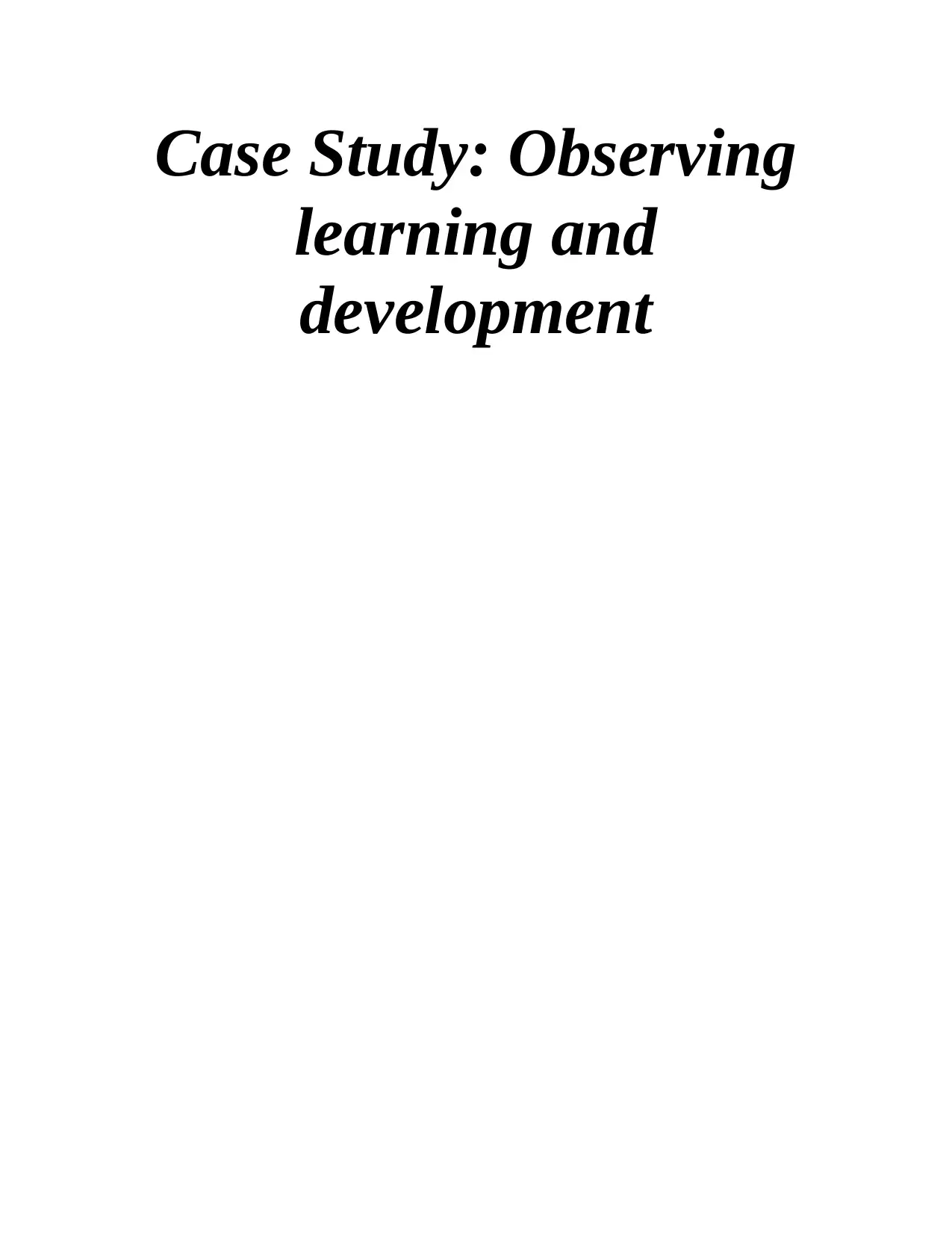
Case Study: Observing
learning and
development
learning and
development
Secure Best Marks with AI Grader
Need help grading? Try our AI Grader for instant feedback on your assignments.

Table of Contents
INTRODUCTION...........................................................................................................................1
Main Body.......................................................................................................................................1
Criteria 1......................................................................................................................................2
Criteria 2......................................................................................................................................3
Criteria 3......................................................................................................................................3
CONCLUSION................................................................................................................................4
REFERENCES ...............................................................................................................................5
APPENDIX......................................................................................................................................6
Appendix..........................................................................................................................................7
INTRODUCTION...........................................................................................................................1
Main Body.......................................................................................................................................1
Criteria 1......................................................................................................................................2
Criteria 2......................................................................................................................................3
Criteria 3......................................................................................................................................3
CONCLUSION................................................................................................................................4
REFERENCES ...............................................................................................................................5
APPENDIX......................................................................................................................................6
Appendix..........................................................................................................................................7

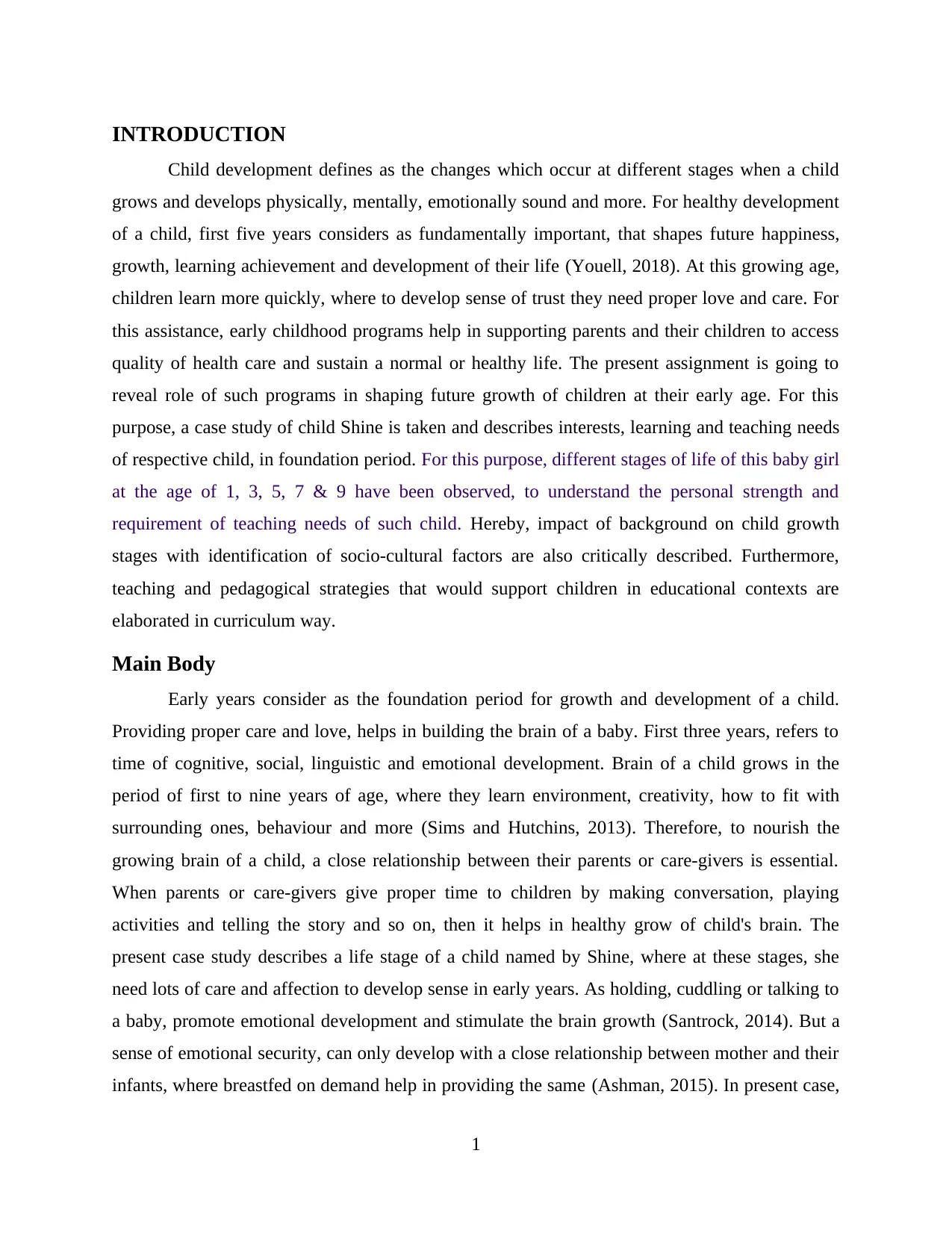
INTRODUCTION
Child development defines as the changes which occur at different stages when a child
grows and develops physically, mentally, emotionally sound and more. For healthy development
of a child, first five years considers as fundamentally important, that shapes future happiness,
growth, learning achievement and development of their life (Youell, 2018). At this growing age,
children learn more quickly, where to develop sense of trust they need proper love and care. For
this assistance, early childhood programs help in supporting parents and their children to access
quality of health care and sustain a normal or healthy life. The present assignment is going to
reveal role of such programs in shaping future growth of children at their early age. For this
purpose, a case study of child Shine is taken and describes interests, learning and teaching needs
of respective child, in foundation period. For this purpose, different stages of life of this baby girl
at the age of 1, 3, 5, 7 & 9 have been observed, to understand the personal strength and
requirement of teaching needs of such child. Hereby, impact of background on child growth
stages with identification of socio-cultural factors are also critically described. Furthermore,
teaching and pedagogical strategies that would support children in educational contexts are
elaborated in curriculum way.
Main Body
Early years consider as the foundation period for growth and development of a child.
Providing proper care and love, helps in building the brain of a baby. First three years, refers to
time of cognitive, social, linguistic and emotional development. Brain of a child grows in the
period of first to nine years of age, where they learn environment, creativity, how to fit with
surrounding ones, behaviour and more (Sims and Hutchins, 2013). Therefore, to nourish the
growing brain of a child, a close relationship between their parents or care-givers is essential.
When parents or care-givers give proper time to children by making conversation, playing
activities and telling the story and so on, then it helps in healthy grow of child's brain. The
present case study describes a life stage of a child named by Shine, where at these stages, she
need lots of care and affection to develop sense in early years. As holding, cuddling or talking to
a baby, promote emotional development and stimulate the brain growth (Santrock, 2014). But a
sense of emotional security, can only develop with a close relationship between mother and their
infants, where breastfed on demand help in providing the same (Ashman, 2015). In present case,
1
Child development defines as the changes which occur at different stages when a child
grows and develops physically, mentally, emotionally sound and more. For healthy development
of a child, first five years considers as fundamentally important, that shapes future happiness,
growth, learning achievement and development of their life (Youell, 2018). At this growing age,
children learn more quickly, where to develop sense of trust they need proper love and care. For
this assistance, early childhood programs help in supporting parents and their children to access
quality of health care and sustain a normal or healthy life. The present assignment is going to
reveal role of such programs in shaping future growth of children at their early age. For this
purpose, a case study of child Shine is taken and describes interests, learning and teaching needs
of respective child, in foundation period. For this purpose, different stages of life of this baby girl
at the age of 1, 3, 5, 7 & 9 have been observed, to understand the personal strength and
requirement of teaching needs of such child. Hereby, impact of background on child growth
stages with identification of socio-cultural factors are also critically described. Furthermore,
teaching and pedagogical strategies that would support children in educational contexts are
elaborated in curriculum way.
Main Body
Early years consider as the foundation period for growth and development of a child.
Providing proper care and love, helps in building the brain of a baby. First three years, refers to
time of cognitive, social, linguistic and emotional development. Brain of a child grows in the
period of first to nine years of age, where they learn environment, creativity, how to fit with
surrounding ones, behaviour and more (Sims and Hutchins, 2013). Therefore, to nourish the
growing brain of a child, a close relationship between their parents or care-givers is essential.
When parents or care-givers give proper time to children by making conversation, playing
activities and telling the story and so on, then it helps in healthy grow of child's brain. The
present case study describes a life stage of a child named by Shine, where at these stages, she
need lots of care and affection to develop sense in early years. As holding, cuddling or talking to
a baby, promote emotional development and stimulate the brain growth (Santrock, 2014). But a
sense of emotional security, can only develop with a close relationship between mother and their
infants, where breastfed on demand help in providing the same (Ashman, 2015). In present case,
1
Secure Best Marks with AI Grader
Need help grading? Try our AI Grader for instant feedback on your assignments.
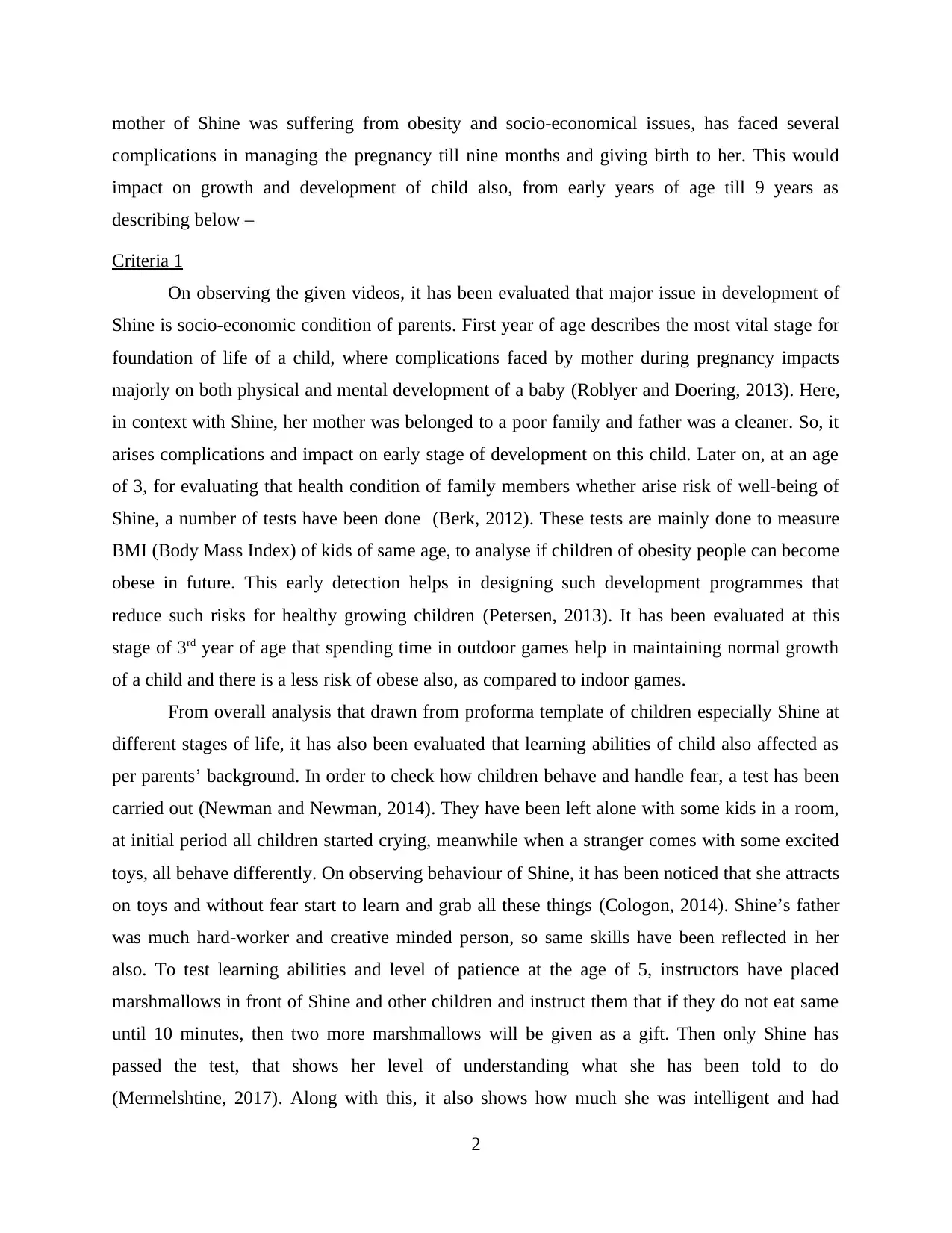
mother of Shine was suffering from obesity and socio-economical issues, has faced several
complications in managing the pregnancy till nine months and giving birth to her. This would
impact on growth and development of child also, from early years of age till 9 years as
describing below –
Criteria 1
On observing the given videos, it has been evaluated that major issue in development of
Shine is socio-economic condition of parents. First year of age describes the most vital stage for
foundation of life of a child, where complications faced by mother during pregnancy impacts
majorly on both physical and mental development of a baby (Roblyer and Doering, 2013). Here,
in context with Shine, her mother was belonged to a poor family and father was a cleaner. So, it
arises complications and impact on early stage of development on this child. Later on, at an age
of 3, for evaluating that health condition of family members whether arise risk of well-being of
Shine, a number of tests have been done (Berk, 2012). These tests are mainly done to measure
BMI (Body Mass Index) of kids of same age, to analyse if children of obesity people can become
obese in future. This early detection helps in designing such development programmes that
reduce such risks for healthy growing children (Petersen, 2013). It has been evaluated at this
stage of 3rd year of age that spending time in outdoor games help in maintaining normal growth
of a child and there is a less risk of obese also, as compared to indoor games.
From overall analysis that drawn from proforma template of children especially Shine at
different stages of life, it has also been evaluated that learning abilities of child also affected as
per parents’ background. In order to check how children behave and handle fear, a test has been
carried out (Newman and Newman, 2014). They have been left alone with some kids in a room,
at initial period all children started crying, meanwhile when a stranger comes with some excited
toys, all behave differently. On observing behaviour of Shine, it has been noticed that she attracts
on toys and without fear start to learn and grab all these things (Cologon, 2014). Shine’s father
was much hard-worker and creative minded person, so same skills have been reflected in her
also. To test learning abilities and level of patience at the age of 5, instructors have placed
marshmallows in front of Shine and other children and instruct them that if they do not eat same
until 10 minutes, then two more marshmallows will be given as a gift. Then only Shine has
passed the test, that shows her level of understanding what she has been told to do
(Mermelshtine, 2017). Along with this, it also shows how much she was intelligent and had
2
complications in managing the pregnancy till nine months and giving birth to her. This would
impact on growth and development of child also, from early years of age till 9 years as
describing below –
Criteria 1
On observing the given videos, it has been evaluated that major issue in development of
Shine is socio-economic condition of parents. First year of age describes the most vital stage for
foundation of life of a child, where complications faced by mother during pregnancy impacts
majorly on both physical and mental development of a baby (Roblyer and Doering, 2013). Here,
in context with Shine, her mother was belonged to a poor family and father was a cleaner. So, it
arises complications and impact on early stage of development on this child. Later on, at an age
of 3, for evaluating that health condition of family members whether arise risk of well-being of
Shine, a number of tests have been done (Berk, 2012). These tests are mainly done to measure
BMI (Body Mass Index) of kids of same age, to analyse if children of obesity people can become
obese in future. This early detection helps in designing such development programmes that
reduce such risks for healthy growing children (Petersen, 2013). It has been evaluated at this
stage of 3rd year of age that spending time in outdoor games help in maintaining normal growth
of a child and there is a less risk of obese also, as compared to indoor games.
From overall analysis that drawn from proforma template of children especially Shine at
different stages of life, it has also been evaluated that learning abilities of child also affected as
per parents’ background. In order to check how children behave and handle fear, a test has been
carried out (Newman and Newman, 2014). They have been left alone with some kids in a room,
at initial period all children started crying, meanwhile when a stranger comes with some excited
toys, all behave differently. On observing behaviour of Shine, it has been noticed that she attracts
on toys and without fear start to learn and grab all these things (Cologon, 2014). Shine’s father
was much hard-worker and creative minded person, so same skills have been reflected in her
also. To test learning abilities and level of patience at the age of 5, instructors have placed
marshmallows in front of Shine and other children and instruct them that if they do not eat same
until 10 minutes, then two more marshmallows will be given as a gift. Then only Shine has
passed the test, that shows her level of understanding what she has been told to do
(Mermelshtine, 2017). Along with this, it also shows how much she was intelligent and had
2
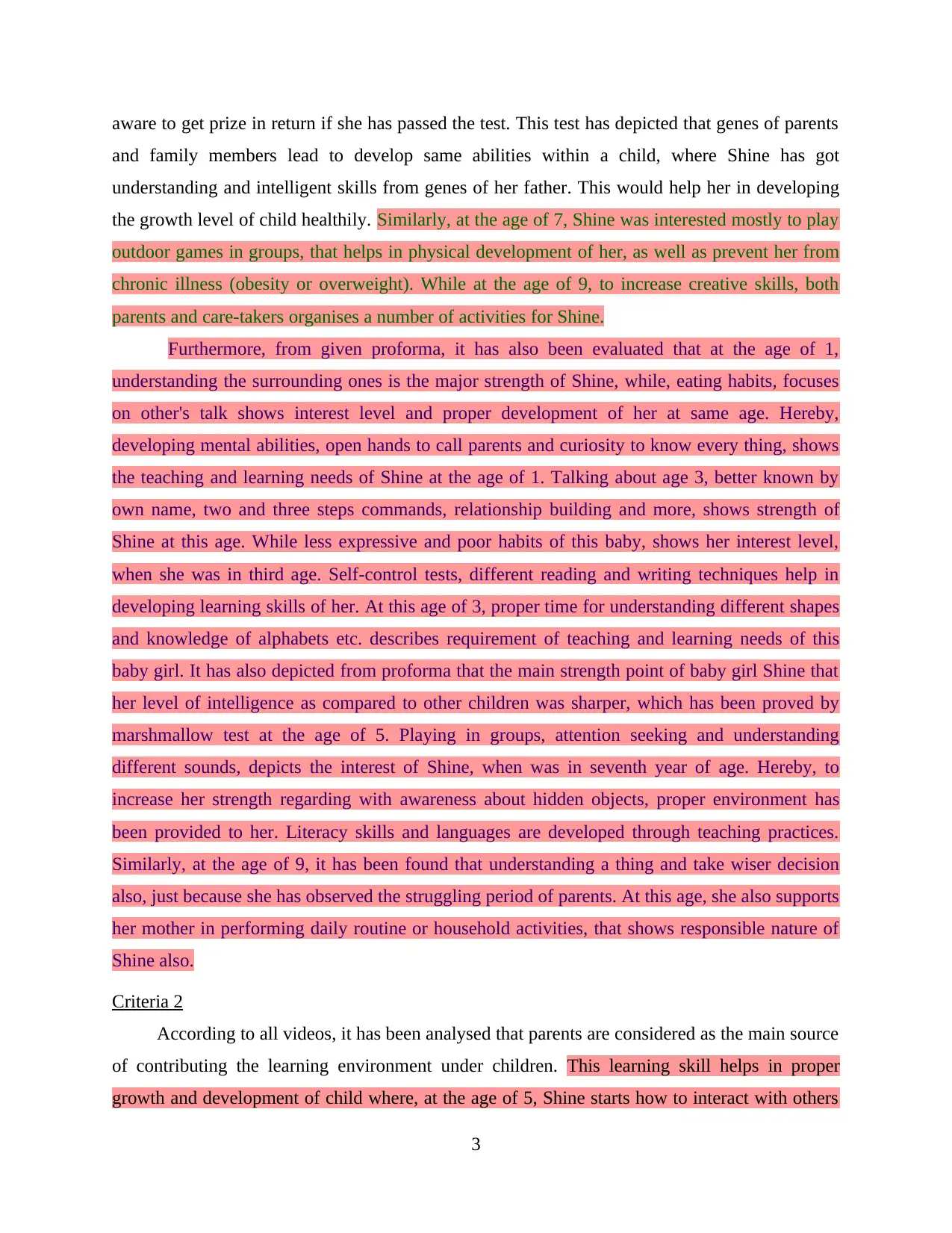
aware to get prize in return if she has passed the test. This test has depicted that genes of parents
and family members lead to develop same abilities within a child, where Shine has got
understanding and intelligent skills from genes of her father. This would help her in developing
the growth level of child healthily. Similarly, at the age of 7, Shine was interested mostly to play
outdoor games in groups, that helps in physical development of her, as well as prevent her from
chronic illness (obesity or overweight). While at the age of 9, to increase creative skills, both
parents and care-takers organises a number of activities for Shine.
Furthermore, from given proforma, it has also been evaluated that at the age of 1,
understanding the surrounding ones is the major strength of Shine, while, eating habits, focuses
on other's talk shows interest level and proper development of her at same age. Hereby,
developing mental abilities, open hands to call parents and curiosity to know every thing, shows
the teaching and learning needs of Shine at the age of 1. Talking about age 3, better known by
own name, two and three steps commands, relationship building and more, shows strength of
Shine at this age. While less expressive and poor habits of this baby, shows her interest level,
when she was in third age. Self-control tests, different reading and writing techniques help in
developing learning skills of her. At this age of 3, proper time for understanding different shapes
and knowledge of alphabets etc. describes requirement of teaching and learning needs of this
baby girl. It has also depicted from proforma that the main strength point of baby girl Shine that
her level of intelligence as compared to other children was sharper, which has been proved by
marshmallow test at the age of 5. Playing in groups, attention seeking and understanding
different sounds, depicts the interest of Shine, when was in seventh year of age. Hereby, to
increase her strength regarding with awareness about hidden objects, proper environment has
been provided to her. Literacy skills and languages are developed through teaching practices.
Similarly, at the age of 9, it has been found that understanding a thing and take wiser decision
also, just because she has observed the struggling period of parents. At this age, she also supports
her mother in performing daily routine or household activities, that shows responsible nature of
Shine also.
Criteria 2
According to all videos, it has been analysed that parents are considered as the main source
of contributing the learning environment under children. This learning skill helps in proper
growth and development of child where, at the age of 5, Shine starts how to interact with others
3
and family members lead to develop same abilities within a child, where Shine has got
understanding and intelligent skills from genes of her father. This would help her in developing
the growth level of child healthily. Similarly, at the age of 7, Shine was interested mostly to play
outdoor games in groups, that helps in physical development of her, as well as prevent her from
chronic illness (obesity or overweight). While at the age of 9, to increase creative skills, both
parents and care-takers organises a number of activities for Shine.
Furthermore, from given proforma, it has also been evaluated that at the age of 1,
understanding the surrounding ones is the major strength of Shine, while, eating habits, focuses
on other's talk shows interest level and proper development of her at same age. Hereby,
developing mental abilities, open hands to call parents and curiosity to know every thing, shows
the teaching and learning needs of Shine at the age of 1. Talking about age 3, better known by
own name, two and three steps commands, relationship building and more, shows strength of
Shine at this age. While less expressive and poor habits of this baby, shows her interest level,
when she was in third age. Self-control tests, different reading and writing techniques help in
developing learning skills of her. At this age of 3, proper time for understanding different shapes
and knowledge of alphabets etc. describes requirement of teaching and learning needs of this
baby girl. It has also depicted from proforma that the main strength point of baby girl Shine that
her level of intelligence as compared to other children was sharper, which has been proved by
marshmallow test at the age of 5. Playing in groups, attention seeking and understanding
different sounds, depicts the interest of Shine, when was in seventh year of age. Hereby, to
increase her strength regarding with awareness about hidden objects, proper environment has
been provided to her. Literacy skills and languages are developed through teaching practices.
Similarly, at the age of 9, it has been found that understanding a thing and take wiser decision
also, just because she has observed the struggling period of parents. At this age, she also supports
her mother in performing daily routine or household activities, that shows responsible nature of
Shine also.
Criteria 2
According to all videos, it has been analysed that parents are considered as the main source
of contributing the learning environment under children. This learning skill helps in proper
growth and development of child where, at the age of 5, Shine starts how to interact with others
3
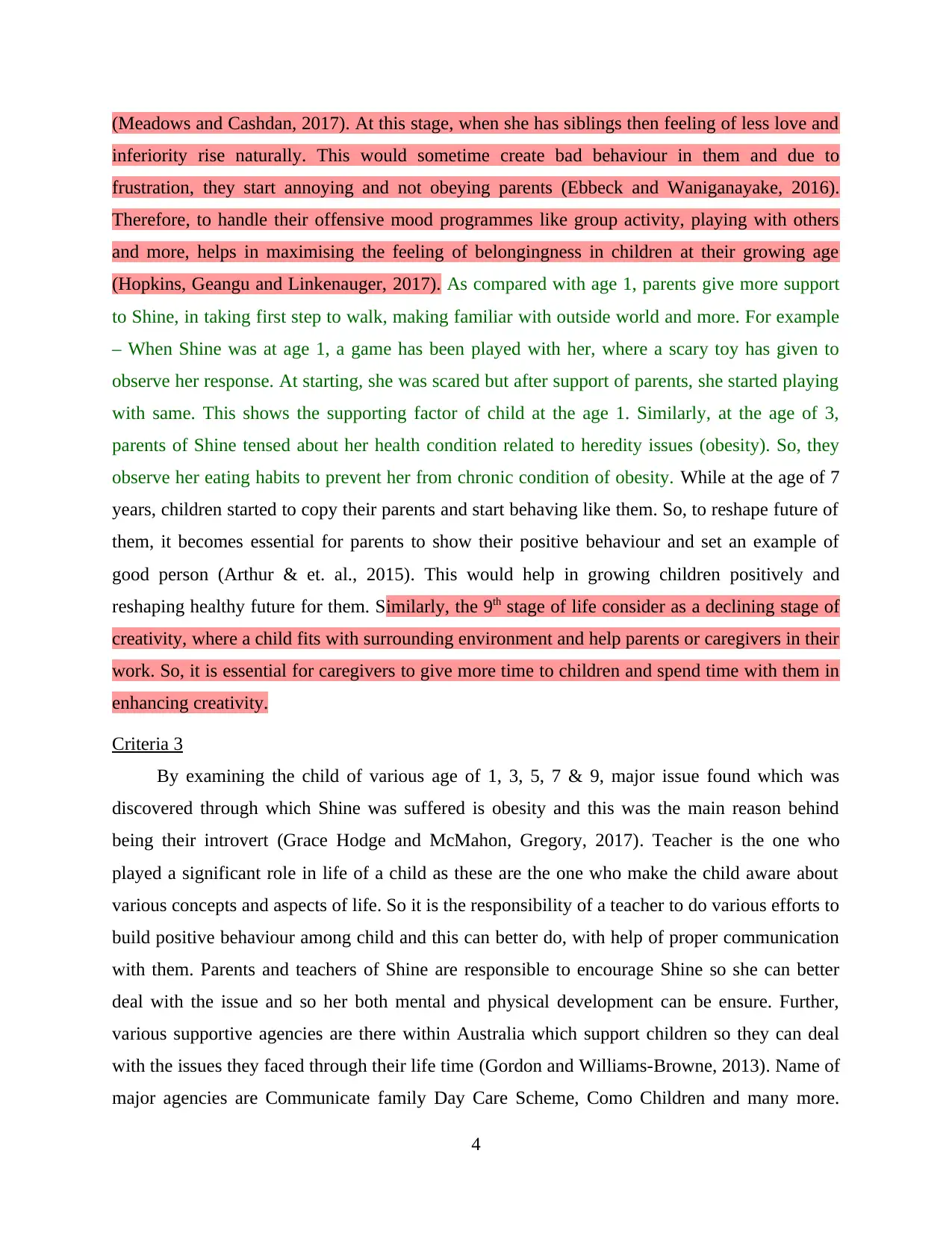
(Meadows and Cashdan, 2017). At this stage, when she has siblings then feeling of less love and
inferiority rise naturally. This would sometime create bad behaviour in them and due to
frustration, they start annoying and not obeying parents (Ebbeck and Waniganayake, 2016).
Therefore, to handle their offensive mood programmes like group activity, playing with others
and more, helps in maximising the feeling of belongingness in children at their growing age
(Hopkins, Geangu and Linkenauger, 2017). As compared with age 1, parents give more support
to Shine, in taking first step to walk, making familiar with outside world and more. For example
– When Shine was at age 1, a game has been played with her, where a scary toy has given to
observe her response. At starting, she was scared but after support of parents, she started playing
with same. This shows the supporting factor of child at the age 1. Similarly, at the age of 3,
parents of Shine tensed about her health condition related to heredity issues (obesity). So, they
observe her eating habits to prevent her from chronic condition of obesity. While at the age of 7
years, children started to copy their parents and start behaving like them. So, to reshape future of
them, it becomes essential for parents to show their positive behaviour and set an example of
good person (Arthur & et. al., 2015). This would help in growing children positively and
reshaping healthy future for them. Similarly, the 9th stage of life consider as a declining stage of
creativity, where a child fits with surrounding environment and help parents or caregivers in their
work. So, it is essential for caregivers to give more time to children and spend time with them in
enhancing creativity.
Criteria 3
By examining the child of various age of 1, 3, 5, 7 & 9, major issue found which was
discovered through which Shine was suffered is obesity and this was the main reason behind
being their introvert (Grace Hodge and McMahon, Gregory, 2017). Teacher is the one who
played a significant role in life of a child as these are the one who make the child aware about
various concepts and aspects of life. So it is the responsibility of a teacher to do various efforts to
build positive behaviour among child and this can better do, with help of proper communication
with them. Parents and teachers of Shine are responsible to encourage Shine so she can better
deal with the issue and so her both mental and physical development can be ensure. Further,
various supportive agencies are there within Australia which support children so they can deal
with the issues they faced through their life time (Gordon and Williams-Browne, 2013). Name of
major agencies are Communicate family Day Care Scheme, Como Children and many more.
4
inferiority rise naturally. This would sometime create bad behaviour in them and due to
frustration, they start annoying and not obeying parents (Ebbeck and Waniganayake, 2016).
Therefore, to handle their offensive mood programmes like group activity, playing with others
and more, helps in maximising the feeling of belongingness in children at their growing age
(Hopkins, Geangu and Linkenauger, 2017). As compared with age 1, parents give more support
to Shine, in taking first step to walk, making familiar with outside world and more. For example
– When Shine was at age 1, a game has been played with her, where a scary toy has given to
observe her response. At starting, she was scared but after support of parents, she started playing
with same. This shows the supporting factor of child at the age 1. Similarly, at the age of 3,
parents of Shine tensed about her health condition related to heredity issues (obesity). So, they
observe her eating habits to prevent her from chronic condition of obesity. While at the age of 7
years, children started to copy their parents and start behaving like them. So, to reshape future of
them, it becomes essential for parents to show their positive behaviour and set an example of
good person (Arthur & et. al., 2015). This would help in growing children positively and
reshaping healthy future for them. Similarly, the 9th stage of life consider as a declining stage of
creativity, where a child fits with surrounding environment and help parents or caregivers in their
work. So, it is essential for caregivers to give more time to children and spend time with them in
enhancing creativity.
Criteria 3
By examining the child of various age of 1, 3, 5, 7 & 9, major issue found which was
discovered through which Shine was suffered is obesity and this was the main reason behind
being their introvert (Grace Hodge and McMahon, Gregory, 2017). Teacher is the one who
played a significant role in life of a child as these are the one who make the child aware about
various concepts and aspects of life. So it is the responsibility of a teacher to do various efforts to
build positive behaviour among child and this can better do, with help of proper communication
with them. Parents and teachers of Shine are responsible to encourage Shine so she can better
deal with the issue and so her both mental and physical development can be ensure. Further,
various supportive agencies are there within Australia which support children so they can deal
with the issues they faced through their life time (Gordon and Williams-Browne, 2013). Name of
major agencies are Communicate family Day Care Scheme, Como Children and many more.
4
Paraphrase This Document
Need a fresh take? Get an instant paraphrase of this document with our AI Paraphraser
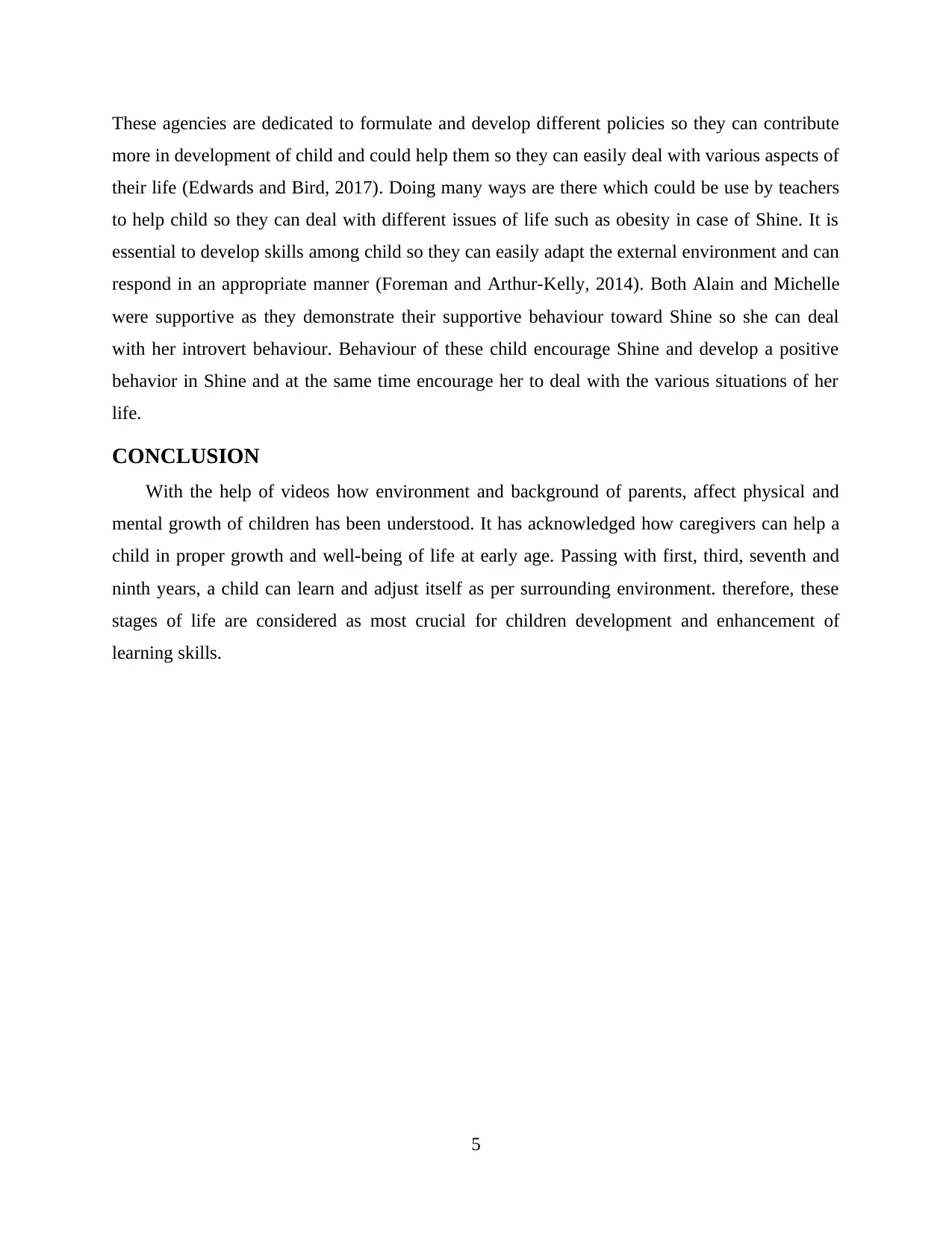
These agencies are dedicated to formulate and develop different policies so they can contribute
more in development of child and could help them so they can easily deal with various aspects of
their life (Edwards and Bird, 2017). Doing many ways are there which could be use by teachers
to help child so they can deal with different issues of life such as obesity in case of Shine. It is
essential to develop skills among child so they can easily adapt the external environment and can
respond in an appropriate manner (Foreman and Arthur-Kelly, 2014). Both Alain and Michelle
were supportive as they demonstrate their supportive behaviour toward Shine so she can deal
with her introvert behaviour. Behaviour of these child encourage Shine and develop a positive
behavior in Shine and at the same time encourage her to deal with the various situations of her
life.
CONCLUSION
With the help of videos how environment and background of parents, affect physical and
mental growth of children has been understood. It has acknowledged how caregivers can help a
child in proper growth and well-being of life at early age. Passing with first, third, seventh and
ninth years, a child can learn and adjust itself as per surrounding environment. therefore, these
stages of life are considered as most crucial for children development and enhancement of
learning skills.
5
more in development of child and could help them so they can easily deal with various aspects of
their life (Edwards and Bird, 2017). Doing many ways are there which could be use by teachers
to help child so they can deal with different issues of life such as obesity in case of Shine. It is
essential to develop skills among child so they can easily adapt the external environment and can
respond in an appropriate manner (Foreman and Arthur-Kelly, 2014). Both Alain and Michelle
were supportive as they demonstrate their supportive behaviour toward Shine so she can deal
with her introvert behaviour. Behaviour of these child encourage Shine and develop a positive
behavior in Shine and at the same time encourage her to deal with the various situations of her
life.
CONCLUSION
With the help of videos how environment and background of parents, affect physical and
mental growth of children has been understood. It has acknowledged how caregivers can help a
child in proper growth and well-being of life at early age. Passing with first, third, seventh and
ninth years, a child can learn and adjust itself as per surrounding environment. therefore, these
stages of life are considered as most crucial for children development and enhancement of
learning skills.
5
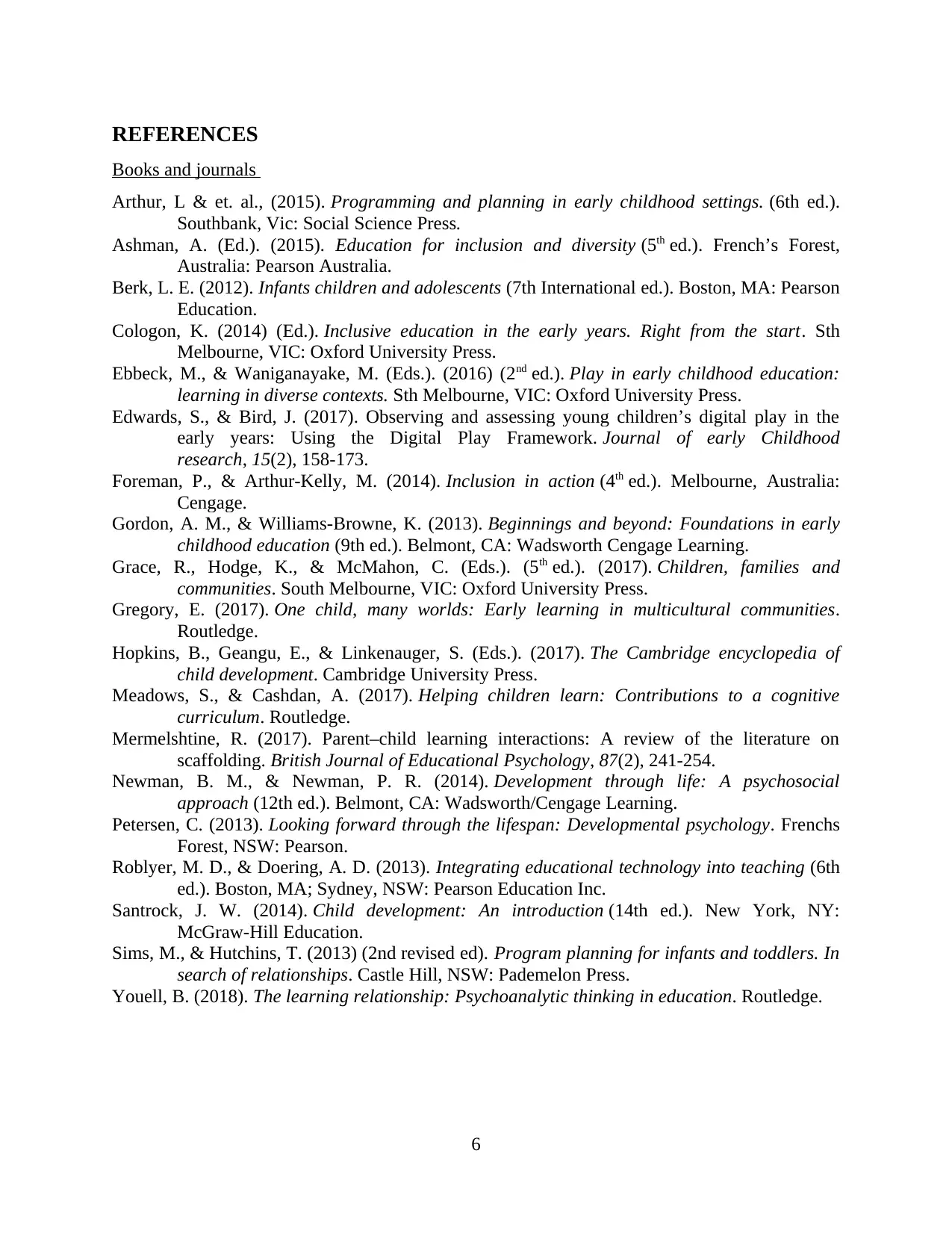
REFERENCES
Books and journals
Arthur, L & et. al., (2015). Programming and planning in early childhood settings. (6th ed.).
Southbank, Vic: Social Science Press.
Ashman, A. (Ed.). (2015). Education for inclusion and diversity (5th ed.). French’s Forest,
Australia: Pearson Australia.
Berk, L. E. (2012). Infants children and adolescents (7th International ed.). Boston, MA: Pearson
Education.
Cologon, K. (2014) (Ed.). Inclusive education in the early years. Right from the start. Sth
Melbourne, VIC: Oxford University Press.
Ebbeck, M., & Waniganayake, M. (Eds.). (2016) (2nd ed.). Play in early childhood education:
learning in diverse contexts. Sth Melbourne, VIC: Oxford University Press.
Edwards, S., & Bird, J. (2017). Observing and assessing young children’s digital play in the
early years: Using the Digital Play Framework. Journal of early Childhood
research, 15(2), 158-173.
Foreman, P., & Arthur-Kelly, M. (2014). Inclusion in action (4th ed.). Melbourne, Australia:
Cengage.
Gordon, A. M., & Williams-Browne, K. (2013). Beginnings and beyond: Foundations in early
childhood education (9th ed.). Belmont, CA: Wadsworth Cengage Learning.
Grace, R., Hodge, K., & McMahon, C. (Eds.). (5th ed.). (2017). Children, families and
communities. South Melbourne, VIC: Oxford University Press.
Gregory, E. (2017). One child, many worlds: Early learning in multicultural communities.
Routledge.
Hopkins, B., Geangu, E., & Linkenauger, S. (Eds.). (2017). The Cambridge encyclopedia of
child development. Cambridge University Press.
Meadows, S., & Cashdan, A. (2017). Helping children learn: Contributions to a cognitive
curriculum. Routledge.
Mermelshtine, R. (2017). Parent–child learning interactions: A review of the literature on
scaffolding. British Journal of Educational Psychology, 87(2), 241-254.
Newman, B. M., & Newman, P. R. (2014). Development through life: A psychosocial
approach (12th ed.). Belmont, CA: Wadsworth/Cengage Learning.
Petersen, C. (2013). Looking forward through the lifespan: Developmental psychology. Frenchs
Forest, NSW: Pearson.
Roblyer, M. D., & Doering, A. D. (2013). Integrating educational technology into teaching (6th
ed.). Boston, MA; Sydney, NSW: Pearson Education Inc.
Santrock, J. W. (2014). Child development: An introduction (14th ed.). New York, NY:
McGraw-Hill Education.
Sims, M., & Hutchins, T. (2013) (2nd revised ed). Program planning for infants and toddlers. In
search of relationships. Castle Hill, NSW: Pademelon Press.
Youell, B. (2018). The learning relationship: Psychoanalytic thinking in education. Routledge.
6
Books and journals
Arthur, L & et. al., (2015). Programming and planning in early childhood settings. (6th ed.).
Southbank, Vic: Social Science Press.
Ashman, A. (Ed.). (2015). Education for inclusion and diversity (5th ed.). French’s Forest,
Australia: Pearson Australia.
Berk, L. E. (2012). Infants children and adolescents (7th International ed.). Boston, MA: Pearson
Education.
Cologon, K. (2014) (Ed.). Inclusive education in the early years. Right from the start. Sth
Melbourne, VIC: Oxford University Press.
Ebbeck, M., & Waniganayake, M. (Eds.). (2016) (2nd ed.). Play in early childhood education:
learning in diverse contexts. Sth Melbourne, VIC: Oxford University Press.
Edwards, S., & Bird, J. (2017). Observing and assessing young children’s digital play in the
early years: Using the Digital Play Framework. Journal of early Childhood
research, 15(2), 158-173.
Foreman, P., & Arthur-Kelly, M. (2014). Inclusion in action (4th ed.). Melbourne, Australia:
Cengage.
Gordon, A. M., & Williams-Browne, K. (2013). Beginnings and beyond: Foundations in early
childhood education (9th ed.). Belmont, CA: Wadsworth Cengage Learning.
Grace, R., Hodge, K., & McMahon, C. (Eds.). (5th ed.). (2017). Children, families and
communities. South Melbourne, VIC: Oxford University Press.
Gregory, E. (2017). One child, many worlds: Early learning in multicultural communities.
Routledge.
Hopkins, B., Geangu, E., & Linkenauger, S. (Eds.). (2017). The Cambridge encyclopedia of
child development. Cambridge University Press.
Meadows, S., & Cashdan, A. (2017). Helping children learn: Contributions to a cognitive
curriculum. Routledge.
Mermelshtine, R. (2017). Parent–child learning interactions: A review of the literature on
scaffolding. British Journal of Educational Psychology, 87(2), 241-254.
Newman, B. M., & Newman, P. R. (2014). Development through life: A psychosocial
approach (12th ed.). Belmont, CA: Wadsworth/Cengage Learning.
Petersen, C. (2013). Looking forward through the lifespan: Developmental psychology. Frenchs
Forest, NSW: Pearson.
Roblyer, M. D., & Doering, A. D. (2013). Integrating educational technology into teaching (6th
ed.). Boston, MA; Sydney, NSW: Pearson Education Inc.
Santrock, J. W. (2014). Child development: An introduction (14th ed.). New York, NY:
McGraw-Hill Education.
Sims, M., & Hutchins, T. (2013) (2nd revised ed). Program planning for infants and toddlers. In
search of relationships. Castle Hill, NSW: Pademelon Press.
Youell, B. (2018). The learning relationship: Psychoanalytic thinking in education. Routledge.
6

APPENDIX
7
7
Secure Best Marks with AI Grader
Need help grading? Try our AI Grader for instant feedback on your assignments.
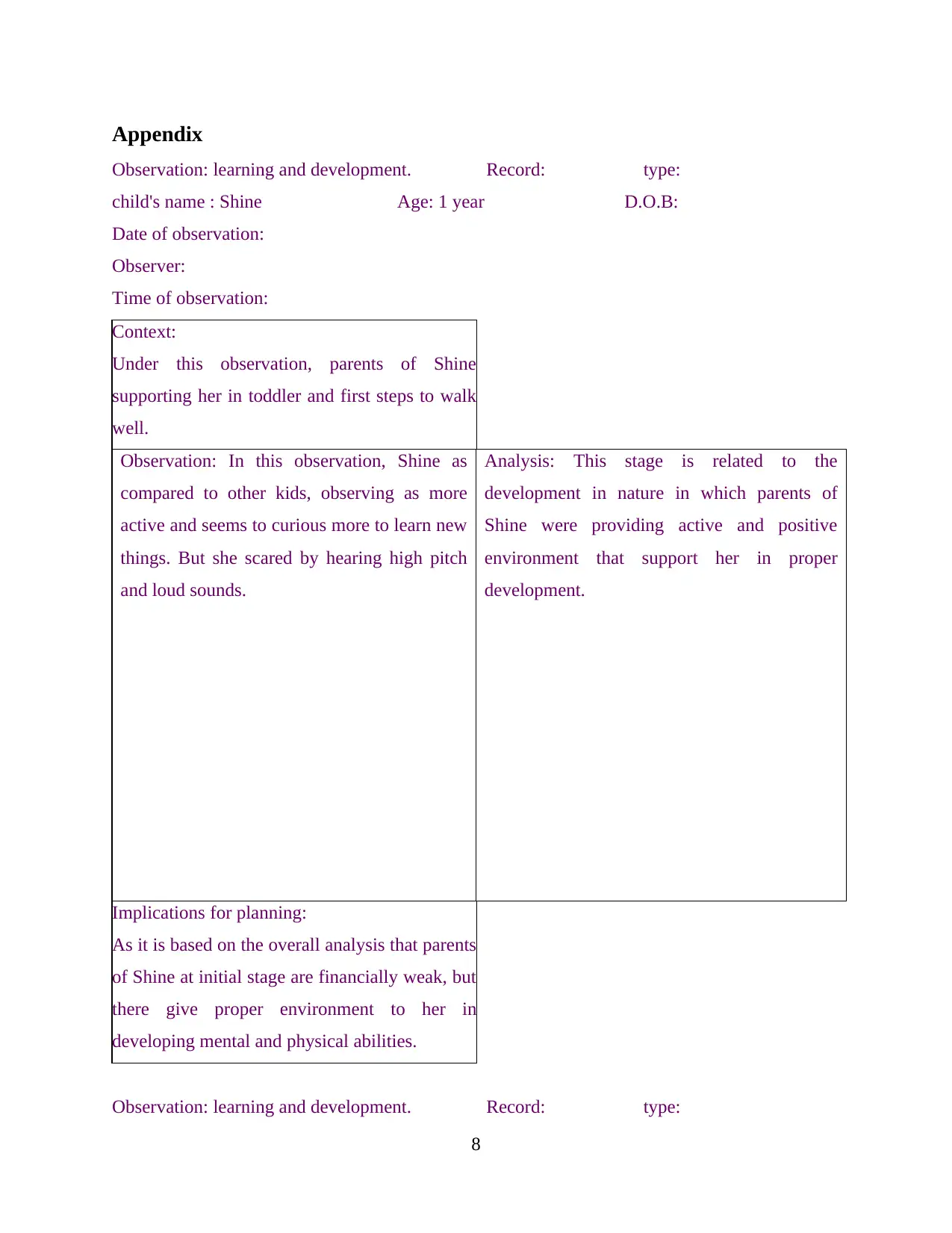
Appendix
Observation: learning and development. Record: type:
child's name : Shine Age: 1 year D.O.B:
Date of observation:
Observer:
Time of observation:
Context:
Under this observation, parents of Shine
supporting her in toddler and first steps to walk
well.
Observation: In this observation, Shine as
compared to other kids, observing as more
active and seems to curious more to learn new
things. But she scared by hearing high pitch
and loud sounds.
Analysis: This stage is related to the
development in nature in which parents of
Shine were providing active and positive
environment that support her in proper
development.
Implications for planning:
As it is based on the overall analysis that parents
of Shine at initial stage are financially weak, but
there give proper environment to her in
developing mental and physical abilities.
Observation: learning and development. Record: type:
8
Observation: learning and development. Record: type:
child's name : Shine Age: 1 year D.O.B:
Date of observation:
Observer:
Time of observation:
Context:
Under this observation, parents of Shine
supporting her in toddler and first steps to walk
well.
Observation: In this observation, Shine as
compared to other kids, observing as more
active and seems to curious more to learn new
things. But she scared by hearing high pitch
and loud sounds.
Analysis: This stage is related to the
development in nature in which parents of
Shine were providing active and positive
environment that support her in proper
development.
Implications for planning:
As it is based on the overall analysis that parents
of Shine at initial stage are financially weak, but
there give proper environment to her in
developing mental and physical abilities.
Observation: learning and development. Record: type:
8
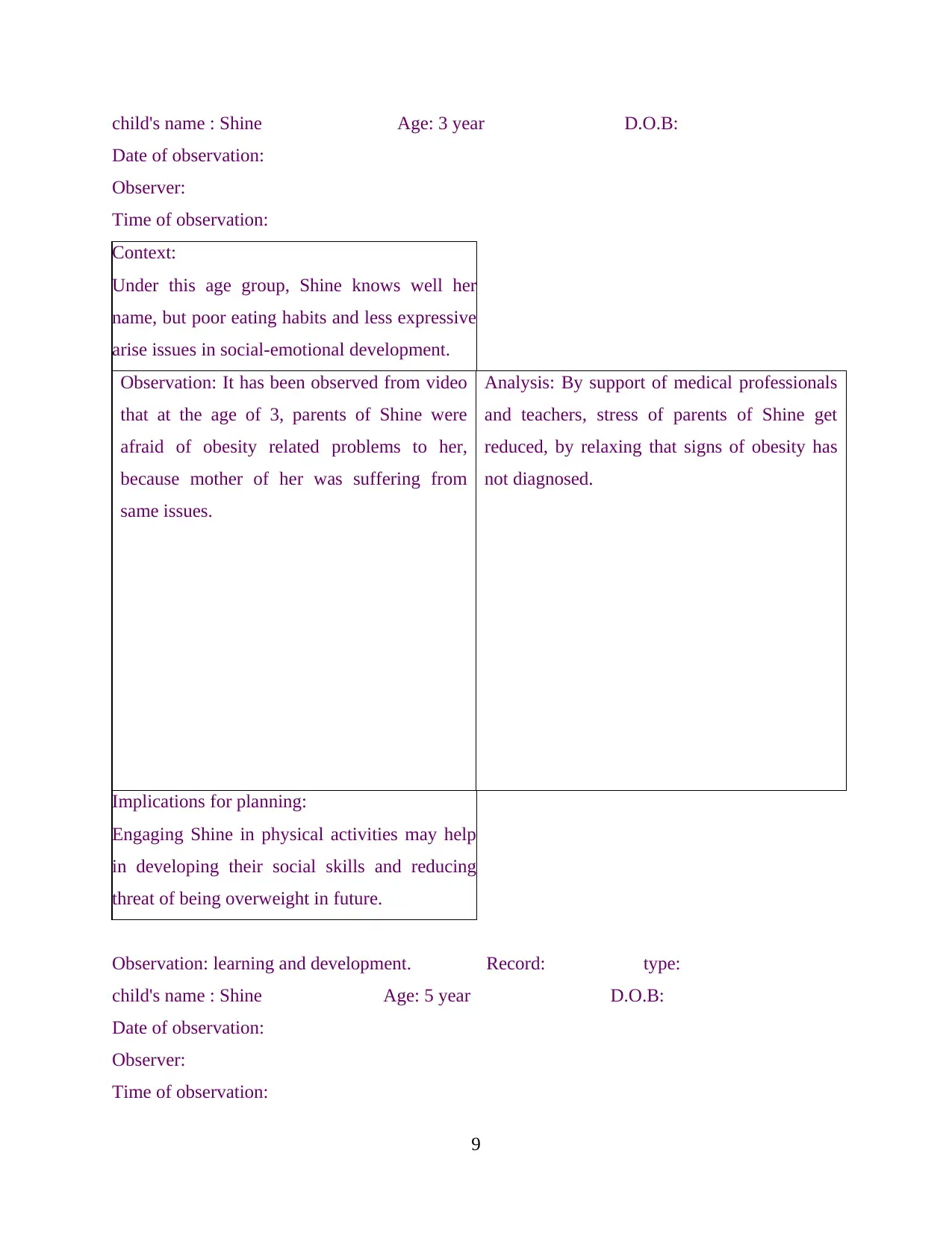
child's name : Shine Age: 3 year D.O.B:
Date of observation:
Observer:
Time of observation:
Context:
Under this age group, Shine knows well her
name, but poor eating habits and less expressive
arise issues in social-emotional development.
Observation: It has been observed from video
that at the age of 3, parents of Shine were
afraid of obesity related problems to her,
because mother of her was suffering from
same issues.
Analysis: By support of medical professionals
and teachers, stress of parents of Shine get
reduced, by relaxing that signs of obesity has
not diagnosed.
Implications for planning:
Engaging Shine in physical activities may help
in developing their social skills and reducing
threat of being overweight in future.
Observation: learning and development. Record: type:
child's name : Shine Age: 5 year D.O.B:
Date of observation:
Observer:
Time of observation:
9
Date of observation:
Observer:
Time of observation:
Context:
Under this age group, Shine knows well her
name, but poor eating habits and less expressive
arise issues in social-emotional development.
Observation: It has been observed from video
that at the age of 3, parents of Shine were
afraid of obesity related problems to her,
because mother of her was suffering from
same issues.
Analysis: By support of medical professionals
and teachers, stress of parents of Shine get
reduced, by relaxing that signs of obesity has
not diagnosed.
Implications for planning:
Engaging Shine in physical activities may help
in developing their social skills and reducing
threat of being overweight in future.
Observation: learning and development. Record: type:
child's name : Shine Age: 5 year D.O.B:
Date of observation:
Observer:
Time of observation:
9
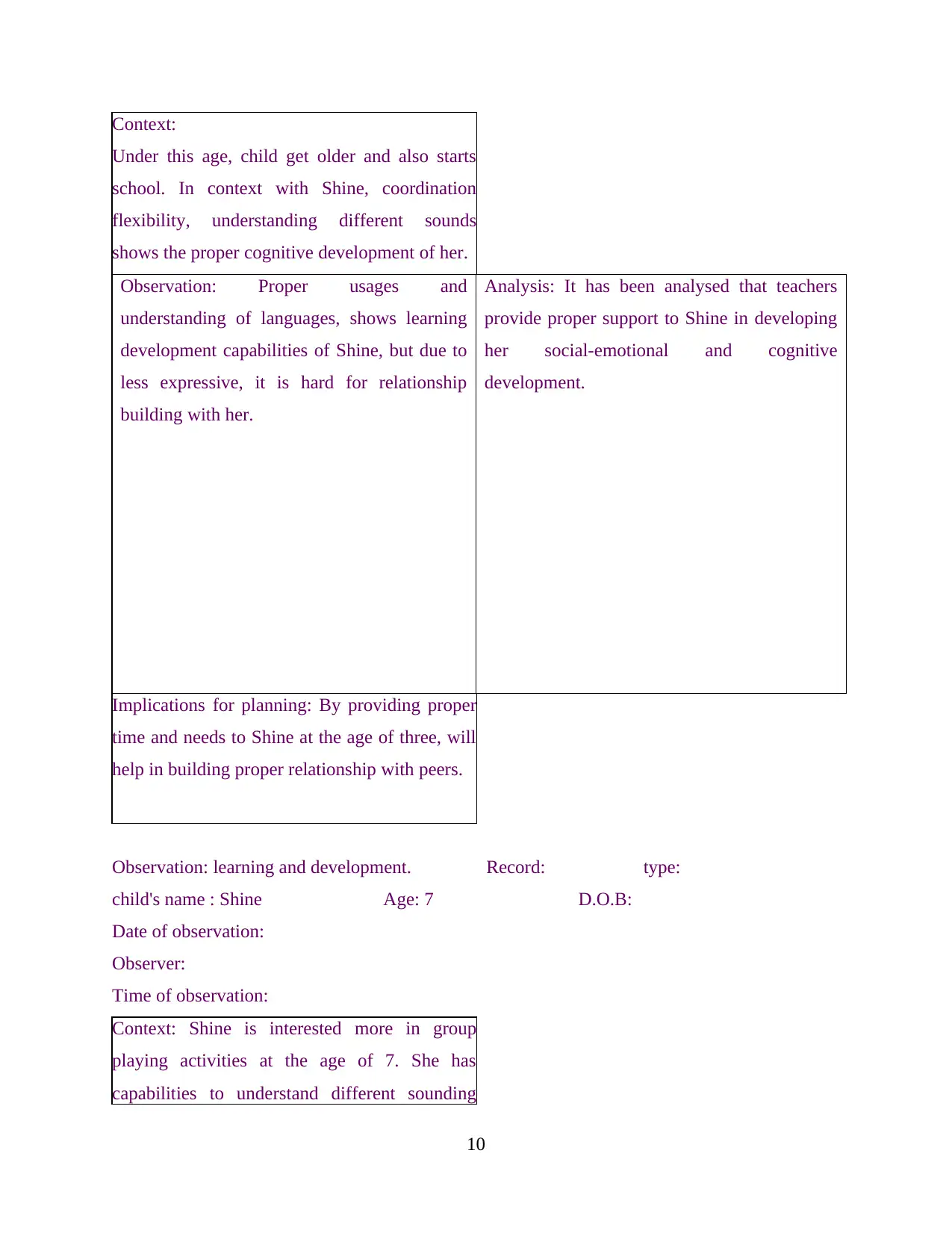
Context:
Under this age, child get older and also starts
school. In context with Shine, coordination
flexibility, understanding different sounds
shows the proper cognitive development of her.
Observation: Proper usages and
understanding of languages, shows learning
development capabilities of Shine, but due to
less expressive, it is hard for relationship
building with her.
Analysis: It has been analysed that teachers
provide proper support to Shine in developing
her social-emotional and cognitive
development.
Implications for planning: By providing proper
time and needs to Shine at the age of three, will
help in building proper relationship with peers.
Observation: learning and development. Record: type:
child's name : Shine Age: 7 D.O.B:
Date of observation:
Observer:
Time of observation:
Context: Shine is interested more in group
playing activities at the age of 7. She has
capabilities to understand different sounding
10
Under this age, child get older and also starts
school. In context with Shine, coordination
flexibility, understanding different sounds
shows the proper cognitive development of her.
Observation: Proper usages and
understanding of languages, shows learning
development capabilities of Shine, but due to
less expressive, it is hard for relationship
building with her.
Analysis: It has been analysed that teachers
provide proper support to Shine in developing
her social-emotional and cognitive
development.
Implications for planning: By providing proper
time and needs to Shine at the age of three, will
help in building proper relationship with peers.
Observation: learning and development. Record: type:
child's name : Shine Age: 7 D.O.B:
Date of observation:
Observer:
Time of observation:
Context: Shine is interested more in group
playing activities at the age of 7. She has
capabilities to understand different sounding
10
Paraphrase This Document
Need a fresh take? Get an instant paraphrase of this document with our AI Paraphraser
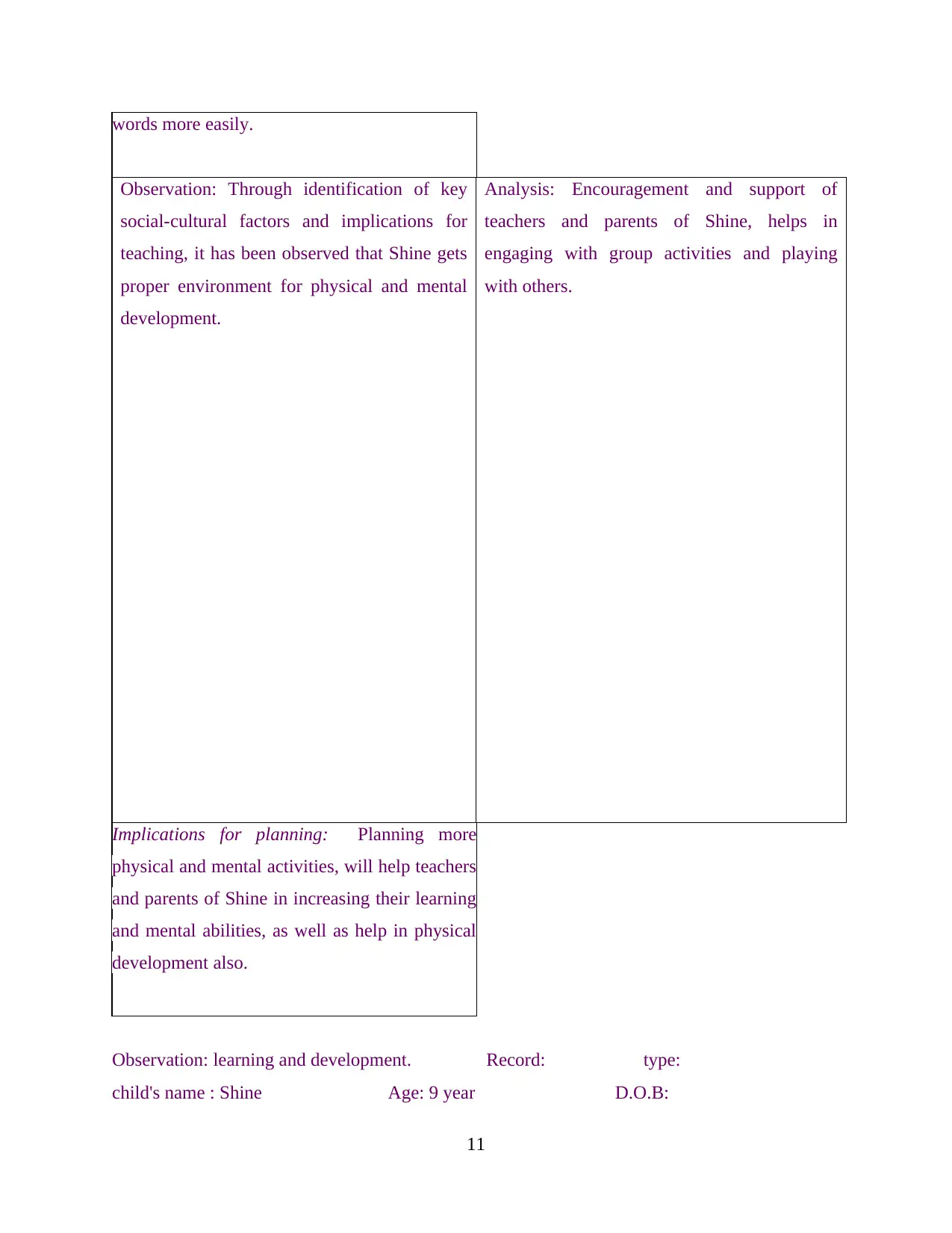
words more easily.
Observation: Through identification of key
social-cultural factors and implications for
teaching, it has been observed that Shine gets
proper environment for physical and mental
development.
Analysis: Encouragement and support of
teachers and parents of Shine, helps in
engaging with group activities and playing
with others.
Implications for planning: Planning more
physical and mental activities, will help teachers
and parents of Shine in increasing their learning
and mental abilities, as well as help in physical
development also.
Observation: learning and development. Record: type:
child's name : Shine Age: 9 year D.O.B:
11
Observation: Through identification of key
social-cultural factors and implications for
teaching, it has been observed that Shine gets
proper environment for physical and mental
development.
Analysis: Encouragement and support of
teachers and parents of Shine, helps in
engaging with group activities and playing
with others.
Implications for planning: Planning more
physical and mental activities, will help teachers
and parents of Shine in increasing their learning
and mental abilities, as well as help in physical
development also.
Observation: learning and development. Record: type:
child's name : Shine Age: 9 year D.O.B:
11
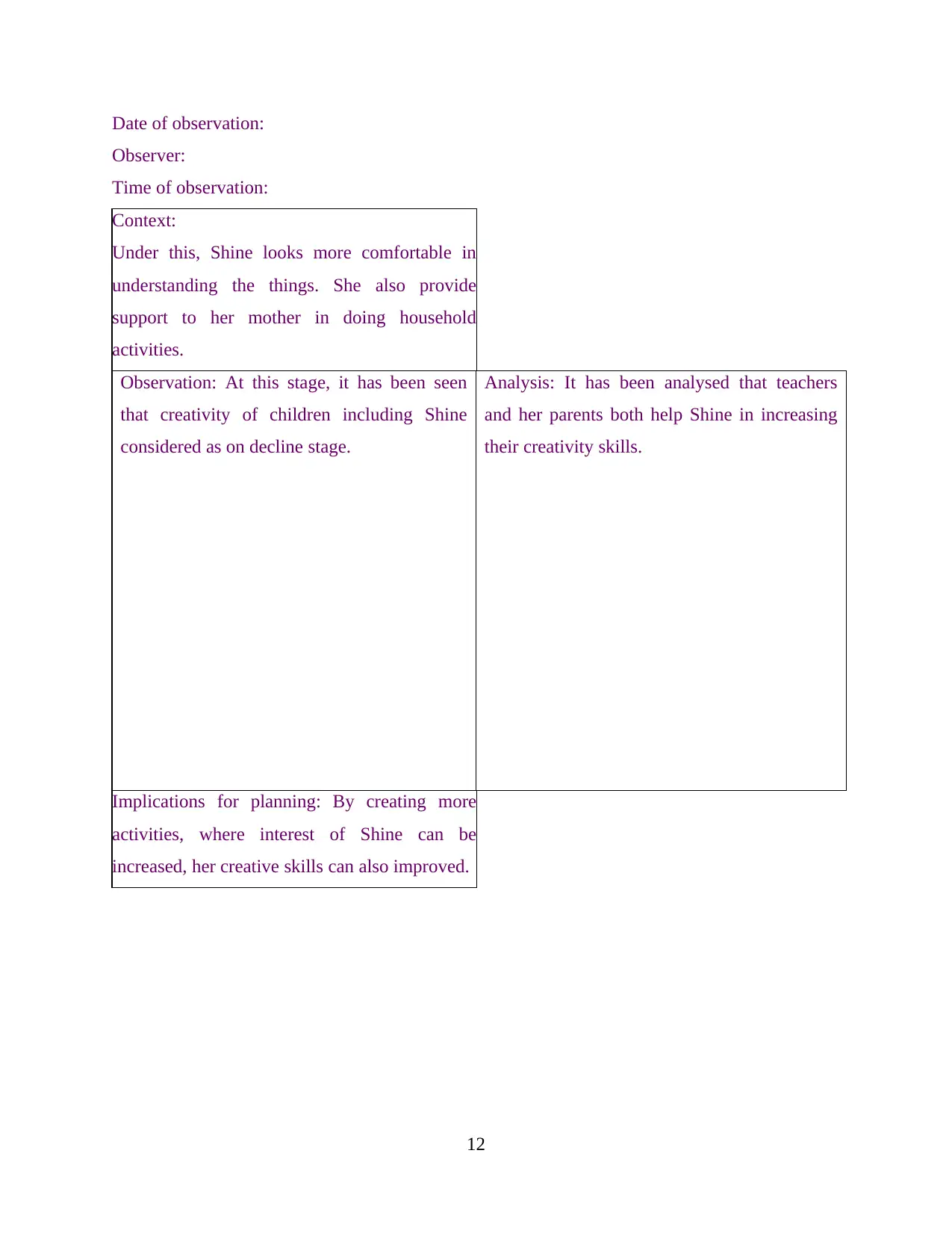
Date of observation:
Observer:
Time of observation:
Context:
Under this, Shine looks more comfortable in
understanding the things. She also provide
support to her mother in doing household
activities.
Observation: At this stage, it has been seen
that creativity of children including Shine
considered as on decline stage.
Analysis: It has been analysed that teachers
and her parents both help Shine in increasing
their creativity skills.
Implications for planning: By creating more
activities, where interest of Shine can be
increased, her creative skills can also improved.
12
Observer:
Time of observation:
Context:
Under this, Shine looks more comfortable in
understanding the things. She also provide
support to her mother in doing household
activities.
Observation: At this stage, it has been seen
that creativity of children including Shine
considered as on decline stage.
Analysis: It has been analysed that teachers
and her parents both help Shine in increasing
their creativity skills.
Implications for planning: By creating more
activities, where interest of Shine can be
increased, her creative skills can also improved.
12

13
1 out of 16
Related Documents
Your All-in-One AI-Powered Toolkit for Academic Success.
+13062052269
info@desklib.com
Available 24*7 on WhatsApp / Email
![[object Object]](/_next/static/media/star-bottom.7253800d.svg)
Unlock your academic potential
© 2024 | Zucol Services PVT LTD | All rights reserved.





